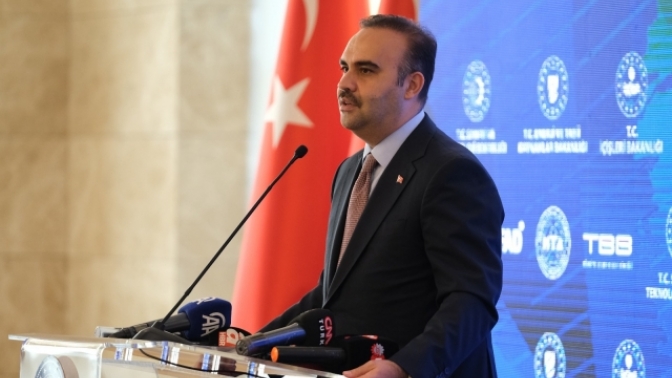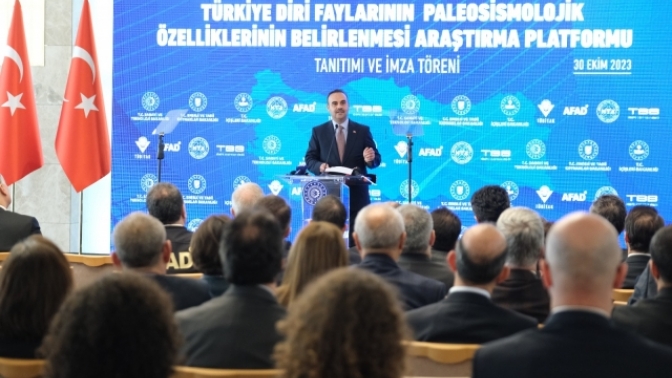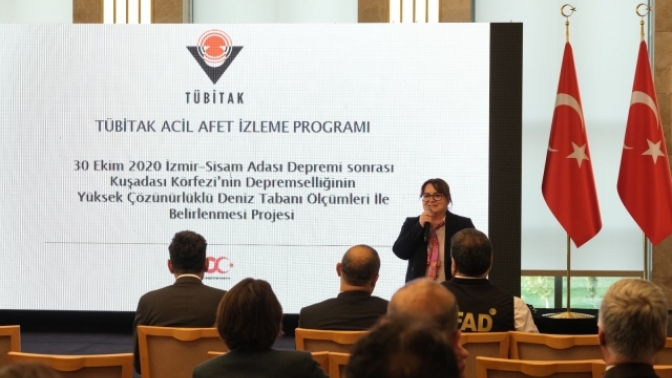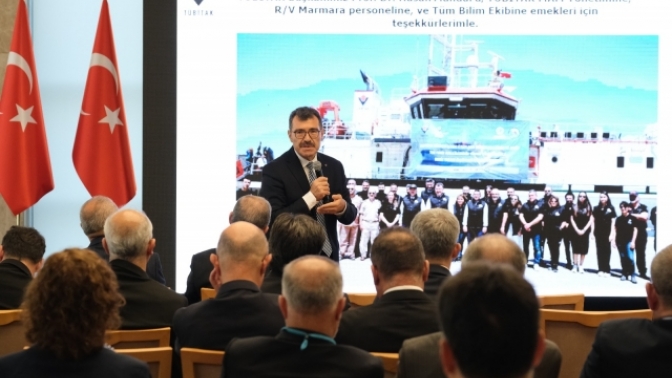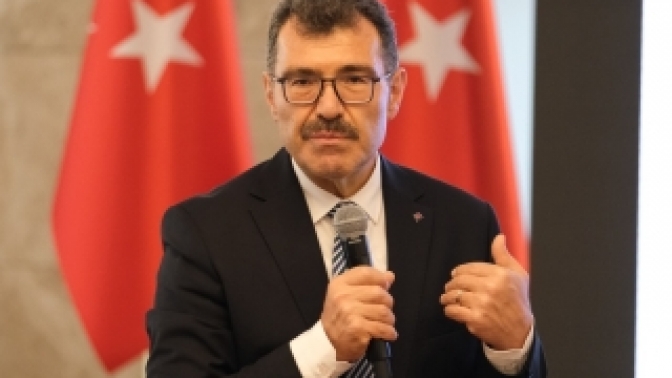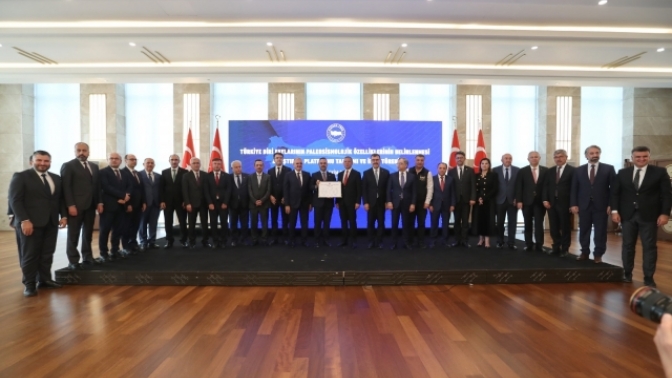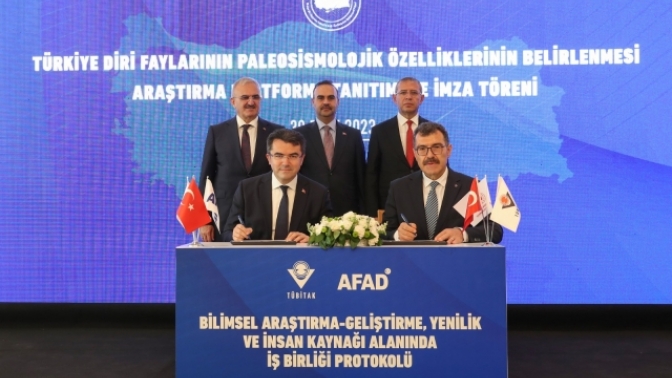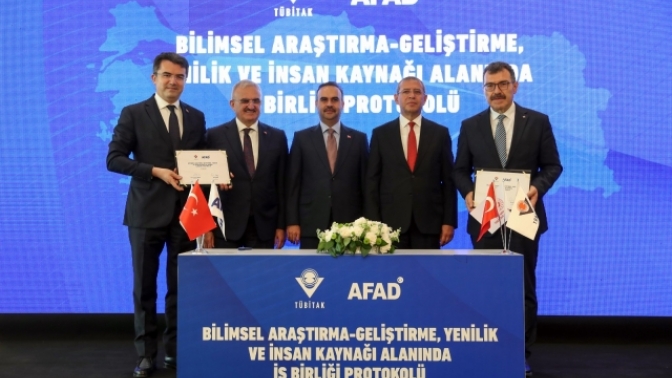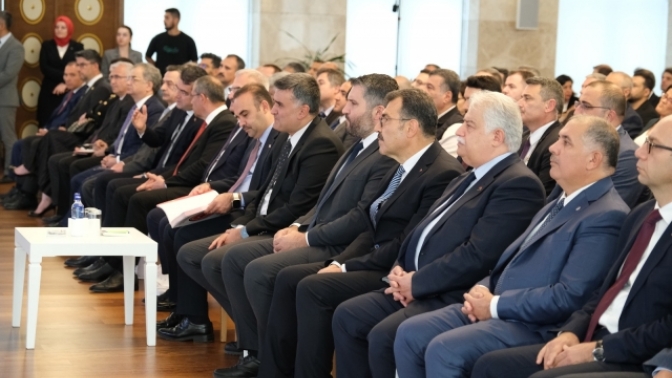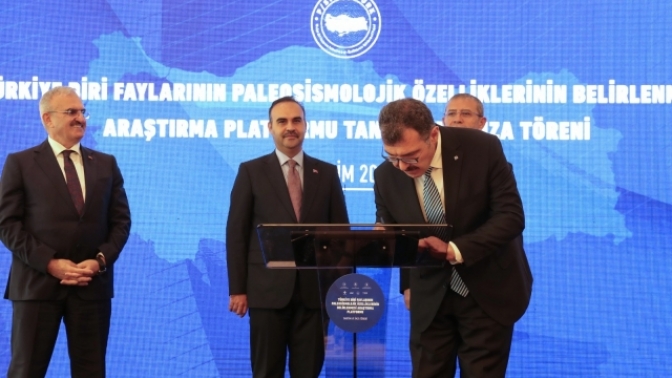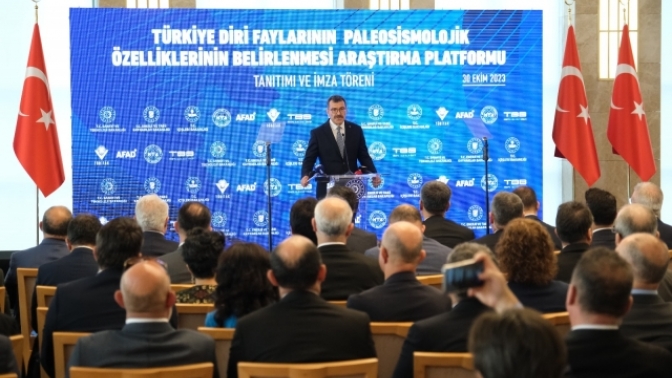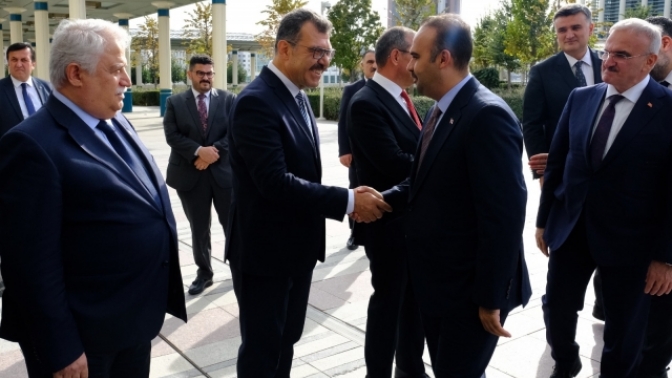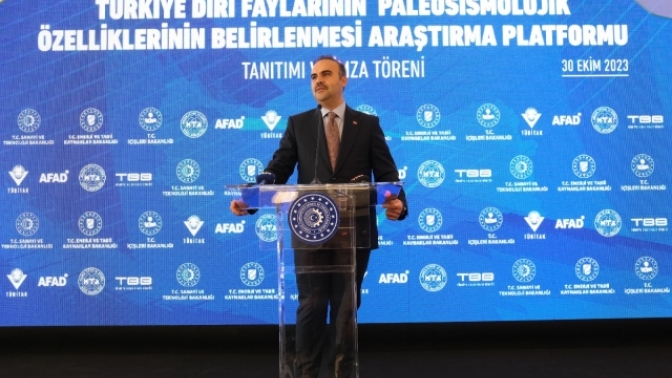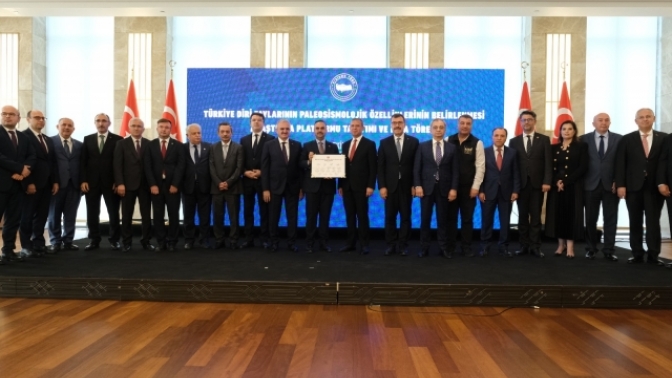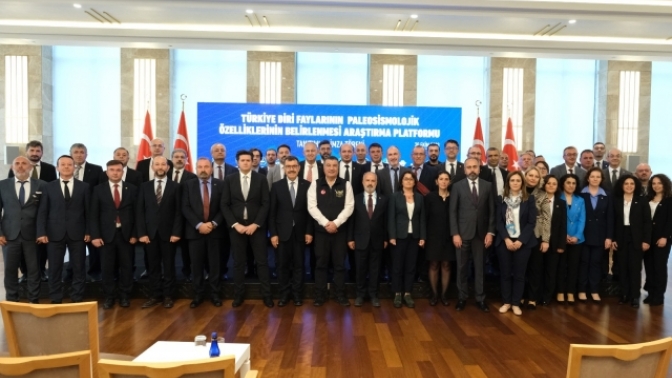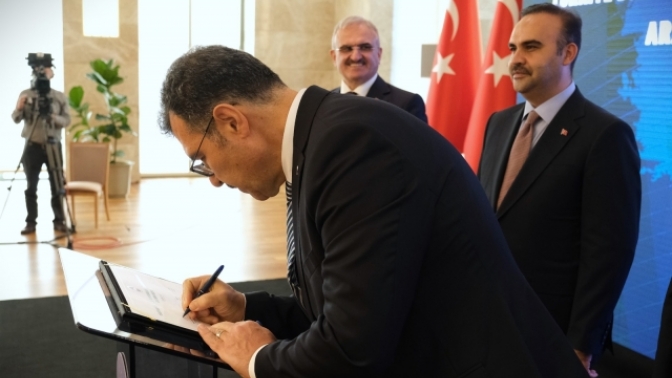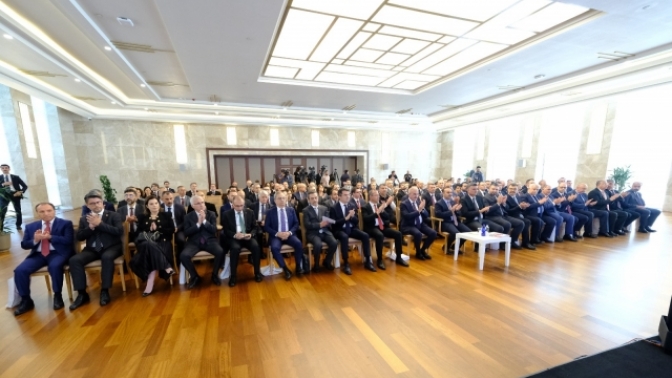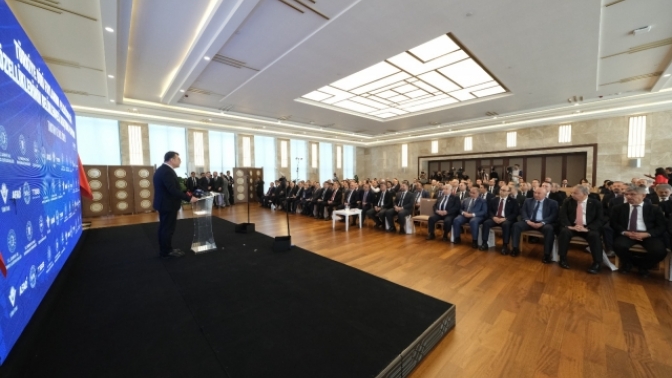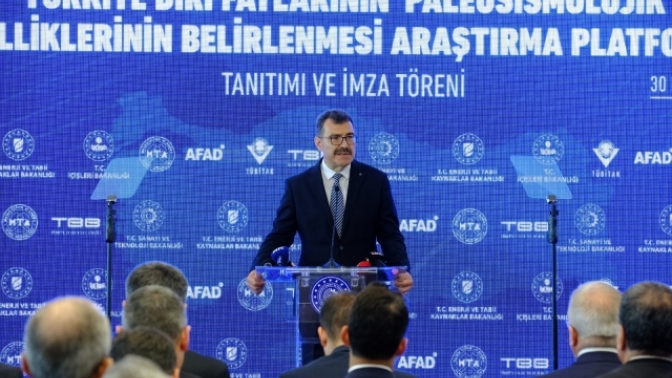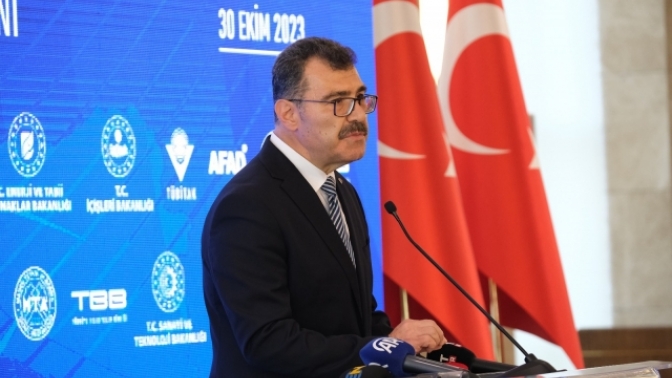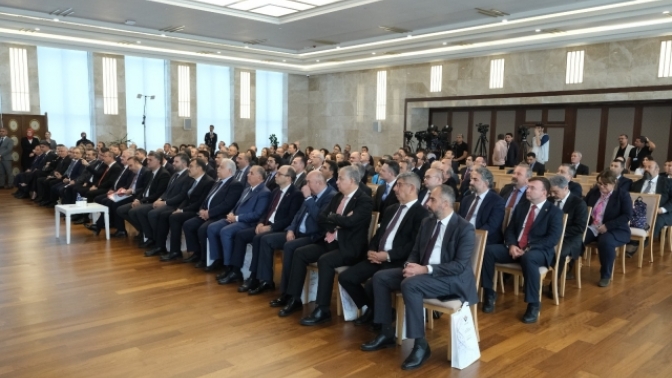The earthquake research carried out by TÜBİTAK jointly with stakeholder organizations was announced to the public at a ceremony attended by the Minister of Industry and Technology, Mehmet Fatih Kacır. At the ceremony, Deputy Minister of Energy and Natural Resources Abdullah Tancan, Deputy Minister of Internal Affairs Münir Karaloğlu, TÜBİTAK President Prof. Dr. Hasan Mandal, AFAD President Governor Okay Memiş, MTA General Manager Vedat Yanık, TBB President Yücel Yılmaz, university rectors and researchers were present.
All relevant stakeholders came together at the presentation and signing ceremony of the Research Platform for the Determination of Paleoseismological Characteristics of Türkiye's Active Faults. By examining the paleoseismological characteristics of Türkiye's Active Faults, earthquake scenarios that may affect residential areas for the regions where they are located will be revealed. With the aim to meet the needs of our country, the Disaster and Emergency Management Presidency and the General Directorate of Mineral Research and Exploration, as customer institutions, joined forces with TÜBİTAK for this project together with expert researchers from universities. Union of Municipalities of Türkiye (TBB) also took part in the project as a facilitating institution.
“Although it is not possible to prevent the earthquake, we can minimize the destruction it causes with approaches that prioritize science.”
Speaking at the ceremony at the Presidential National Library, Minister of Industry and Technology Mehmet Fatih Kacır stated that they are trying to heal the wounds of the Kahramanmaraş-centered earthquakes and return the cities to their old days and said, "Earthquake is a reality of our country, although it is not possible to prevent the earthquake, we can minimize the destruction it creates with approaches that prioritize science. "
Kacır stated that the different active faultsthat emerged as a result of Anatolia being squeezed between the Eurasian plates in the north and the African and Arabian plates in the south causes Türkiye to experience significant earthquakes. He said that the country has experienced many earthquake disasters, from the İstanbul earthquake in 1509 to the Kahramanmaraş earthquake on February 6th.
Kacır stated that following the earthquake in Kahramanmaraş, the Ministry took action in coordination with public institutions and organizations and industrialists, especially AFAD and the Türk Kızılay (Turkish Red Crescent).
Stating that they supported the investments in 65 districts that were heavily affected by the earthquake with the highest level of investment incentives, Kacır explained that they issued incentive certificates for 481 investments worth 84 billion liras, which will create more than 25 thousand jobs.
Kacır stated that they considered 1222 investment incentive certificates issued before the earthquake but could not continue their investments as completed, and that they extended the incentive certificate periods for 5 thousand 962 ongoing investments by 3 years without any request.
1.36 billion lira for 124 projects that will support the recovery of the earthquake region through development agencies and regional development administrations. Stating that they transferred resources, Kacır gave information about the work in the earthquake region and the support they provided.
He also shared TÜBİTAK's support for earthquake victims after the earthquake: "We supported the R&D projects of our researchers with "BİÇABA" and provided scholarship opportunities to nearly 2,500 of our students and researchers with the "BİÇABA" call. We supported our companies located in the earthquake zone with “TEKNOÇABA”. We alleviated the wounds of more than 50 thousand children with our "Science is Everywhere" activities. “We reunited our missing children with their relatives with the DerinGÖRÜ Facial Recognition System.”
"We will reveal earthquake scenarios that will affect residential areas"
Stating that they are trying to heal the wounds of the earthquake and return the cities to their old days, Kacır said, "Earthquake is a reality of our country, although it is not possible to prevent the earthquake, we can minimize the destruction it creates with approaches that prioritize science."
They have made significant progress since the 1999 Gölcük earthquake. Kacır said that during the earthquake in question, there were days when the government of the period was helpless to reach İstanbul.
Kacır said: "Today, we have reached the position of a country that takes a rapid position and brings its state together with its citizens. TÜBİTAK is one of our important institutions in reaching this position. We have carried out site classification and seismic hazard studies in various provinces in the last 20 years with our TÜBİTAK-MAM Earth Sciences Research Group. In our studies with local governments, "We have completed projects to determine earthquake hazard and risk in Kocaeli, İstanbul, Yalova, Bursa, Balıkesir and Gaziantep."
Kacır stated that within the scope of the Post-Earthquake Emergency Observation Research (DEPAR) Project, they observed the seismological characteristics of the faults after the Bodrum, İzmir, Niğde, Düzce and Kahramanmaraş earthquakes, and that they will minimize the damage to residential areas against possible devastating earthquakes by identifying active fault lines.
Pointing out that with the project, scientists will examine the paleoseismological characteristics of active faults in Türkiye, Kacır gave the following information:
"With our scientists, we will reveal earthquake scenarios that may affect residential areas in the regions where active faults are located. Our scientists will determine the geometries of active faults, the recurrence periods of earthquakes, the last surface rupture dates and slip rates, and the average slip amount in each earthquake. These data may occur depending on different scenarios. It is of critical importance in determining the estimated largest earthquake magnitude. We expect to complete the analysis of 128 fault segments within 2 years. In the project to be carried out under the coordination of TÜBİTAK MAM, AFAD and MTA will be involved as the need authority institutions, and the Union of Municipalities of Türkiye will be involved as the organization that will encourage the implementation of the project results by local governments. 19 work packages, 22 universities, 14 of which will be project managers, will contribute to the project. "The main financing of the 115 million lira project will be provided by TÜBİTAK."
Stating that 100 researchers and 90 TÜBİTAK scholars will take part in the project to be carried out in public-university cooperation, Kacır explained that 40 of the scholars will be undergraduate students who are TÜBİTAK STAR scholars.
Kacır gave the following statements:
"The project will serve as a school for earthquake research in Türkiye. Today, we will witness the results of the 'Determination of the Seismicity and Active Tectonic Features of Faults in Kuşadası Bay with High-Resolution Seafloor Measurements Project'. With the work we carried out under the coordination of TÜBİTAK MAM after the İzmir earthquake, we will witness the results of the Kuşadası Bay" "We have had the opportunity to create a detailed fault map of the region. We have reached the geological traces of the earthquakes that have occurred in the region throughout history. In the light of the data we obtained from the projects we carry out, we will overcome the earthquakes that may occur in the region with the least damage."
“We must use our forces responsibly and based on science.” “We need to unite.”
President of TÜBİTAK Prof. Dr. Hasan Mandal also expressed his satisfaction in holding such a meeting on the first day of Türkiye's second century.
Reminding that three years have passed since the İzmir earthquake and pointing out that this meeting has become even more meaningful, Mandal said that he experienced the Elazığ Sivrice earthquake during his presidency and that he went to the field after that earthquake: "When I met with the researchers, I noted what kind of difficulties they experienced in the field. They explained that they had to go to the field immediately. We created a program that was supported within 24 hours. It was applied in the İzmir earthquake. Then, after the February 6 earthquakes, 577 researchers went to the field and carried out 125 projects with the support of TÜBİTAK. Our researchers were mobilized in the fields of earth sciences, construction, industry, health, history, sociology, social and human sciences. We organized a virtual conference on March 30, 2023. We currently provide you with a booklet containing the outputs and project summaries of that conference. “We conveyed it.”
Noting that they had discussions on how we can be prepared for the earthquake, Mandal said, “I would like to thank AFAD and MTA wholeheartedly for the expansion of our common platform created after the İzmir earthquake. Within that responsibility, we need to join forces on a science-based basis. All our relevant universities and 22 universities, including 14 executive universities, are contributing.”
“The work we will do will be an exemplary study in terms of resilience to disasters.”
Mandal also shared the process of establishing the platform; “It was decided to create a platform where our relevant stakeholders and researchers at universities come together. Of course, there is a very strong support from our Ministry. The Union of Municipalities of Türkiye will also be the implementer of the results from this. We will do what is necessary for our researchers. A total of 190 people will take part. The project supported by TÜBİTAK with approximately 115 Million TL 20% of the budget will be covered by AFAD through co-financing. "51 of the 128 fault segments will be covered by MTA with its own resources."
Prof. Dr. Mandal said, “The work we will do will be a total exemplary study in terms of resilience to disasters. We want its impact to spread to other areas. This is how the Covid-19 platform was formed during the pandemic period. And it still works. “I think this platform will have an impact against disasters.” made his evaluations.
Paleoseismology-based studies will be carried out on active faults or fault segments.
Paleoseismology-based studies will be carried out on prioritized active faults or fault segments, the geometries of active faults will be revealed, the project will determine recurrence periods, date the last surface rupture, obtain slip rate data, determine the average slip amount in each earthquake, determine the estimated largest earthquake magnitude that may occur. It is aimed to determine the estimated largest earthquake magnitude that may occur depending on multi-segment rupture scenarios.
Türkiye Earthquake Hazard Map will be updated
With the outputs to be obtained as a result of the project, earthquake damages to residential areas against possible devastating earthquakes in densely populated areas will be minimized.
This study, which will contribute to the development of databases, will be an important data source that can be used in updating the Türkiye Earthquake Hazard Map created by AFAD.
The scientific and technical data to be obtained at the end of the project will be an important guide for the relevant institutions in the planning of investment projects and residential areas in our country, in the location selection of organized industrial zones, and in infrastructure projects such as transportation and energy transmission lines.
TÜBİTAK and AFAD increase their cooperation
To increase the quality of scientific research, development and innovation projects in the field of disaster and emergency management, a separate protocol was signed between TÜBİTAK and AFAD to contribute to the development of qualified human resources and projects and to strengthen cooperation between the parties in the field of disaster management.
Unknown facts about the İzmir earthquake come to light
3-year studies on the İzmir Earthquake were also announced to the public. The project "Determining the Seismicity and Active Tectonic Characteristics of Faults in Kuşadası Bay with High Resolution Seafloor Measurements", which started as a TÜBİTAK internally supported project immediately after the earthquake, was completed.
The project, which is the first national marine research project carried out by our country's researchers and institutions with full national support in both national and international waters in the Aegean Sea, is under the coordination of TÜBİTAK Marmara Research Center (TÜBİTAK MAM) and under the leadership of İstanbul Technical University and Dokuz Eylül University. In partnership with Dokuz Eylül University, İstanbul University, Middle East Technical University, Boğaziçi University. Within the scope of the project, two science expeditions were organized between May and June in 2021 and 2022.
Dr. Gülsen Uçarkuş said, “With this study, a detailed fault map of Kuşadası Bay was prepared. We have found geological traces of earthquakes that have occurred in this region throughout history. "We examined the fault mechanisms in more depth in the light of the data we obtained in the projects we carried out, and we will create our regional city planning with new information."
TÜBİTAK, which pressed all the buttons with the awareness of Türkiye's earthquake reality, took another big step towards reaching a solution in the fight against earthquakes with the approach of working together and succeeding together.


